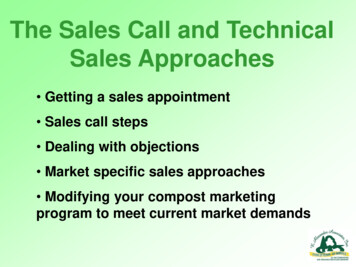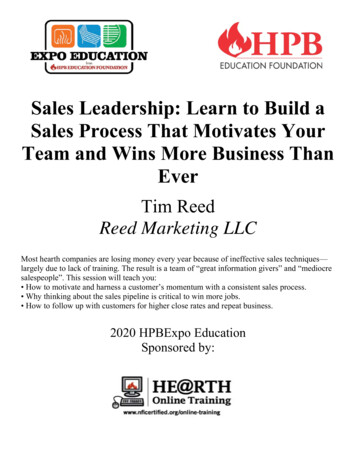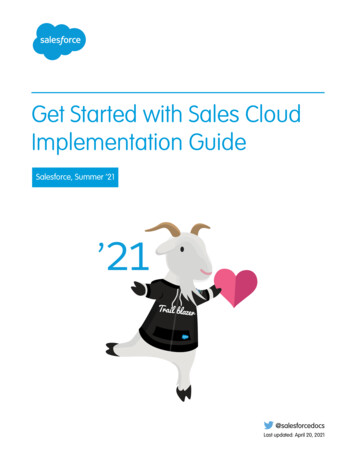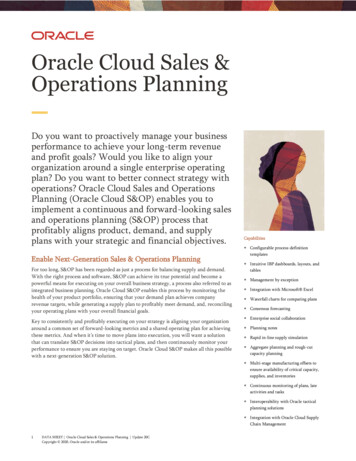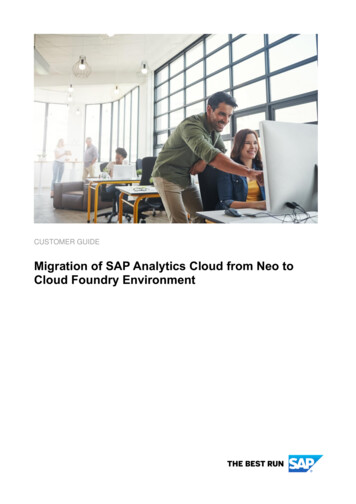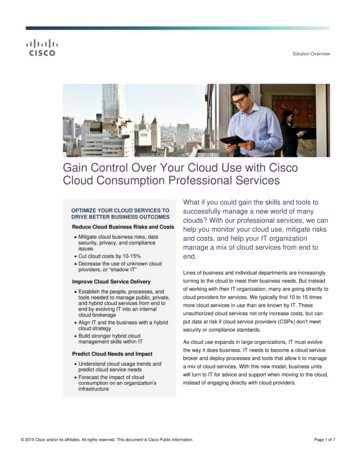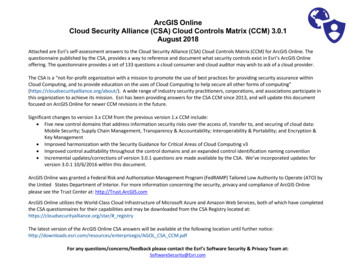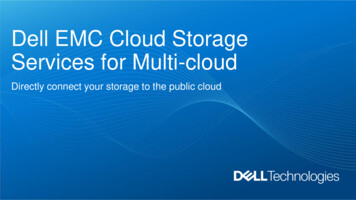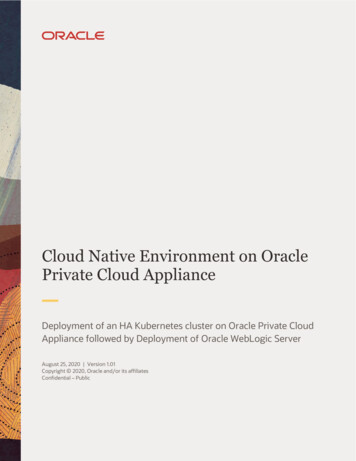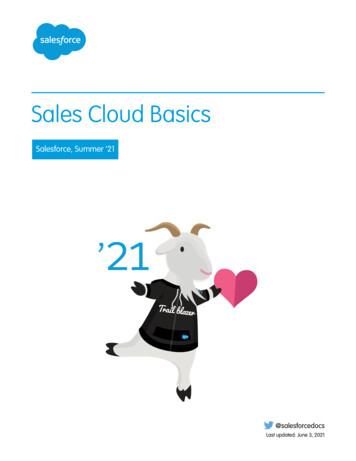
Transcription
Sales Cloud BasicsSalesforce, Summer ’21@salesforcedocsLast updated: June 3, 2021
Copyright 2000–2021 salesforce.com, inc. All rights reserved. Salesforce is a registered trademark of salesforce.com, inc.,as are other names and marks. Other marks appearing herein may be trademarks of their respective owners.
CONTENTSSales Cloud Basics . . . . . . . . . . . . . . . . . . . . . . . . . . . . . . . . . . . . . . . . . . . . . . . . . . . . 1Campaign and Bring in Leads . . . . . . . . . . . . . . . . . . . . . . . . . . . . . . . . . . . . . . . . . . . . . 1Turn Opportunities into Deals . . . . . . . . . . . . . . . . . . . . . . . . . . . . . . . . . . . . . . . . . . . . 106Manage Accounts and Contacts . . . . . . . . . . . . . . . . . . . . . . . . . . . . . . . . . . . . . . . . . . 191Manage a Sales Team . . . . . . . . . . . . . . . . . . . . . . . . . . . . . . . . . . . . . . . . . . . . . . . . 272Artificial Intelligence and Sales Cloud . . . . . . . . . . . . . . . . . . . . . . . . . . . . . . . . . . . . . . . 481More Sales Features . . . . . . . . . . . . . . . . . . . . . . . . . . . . . . . . . . . . . . . . . . . . . . . . . . 486Resources for the Sales Professional . . . . . . . . . . . . . . . . . . . . . . . . . . . . . . . . . . . . . . . 512Index . . . . . . . . . . . . . . . . . . . . . . . . . . . . . . . . . . . . . . . . . . . . . . . . . . . . . . . . . . . . 513
SALES CLOUD BASICSThe Sales Cloud provides everything you need to manage your business. Generate the best leads, manage opportunities through thesales pipleline, and cultivate relationships with exisiting accounts. Plus, forecast revenues, set up sales territories, and organize your repsinto selling teams.Campaign and Bring in LeadsUse leads to track prospects as you build your pipeline. Create campaigns to market directly to your leads so you can to turn prospectsinto deals.Turn Opportunities into DealsMove opportunities through the sales process, and track exactly what you're selling and for how much.Manage Accounts and ContactsTrack the people and companies you do business with. Store information, collaborate on accounts, access the records you need.Manage a Sales TeamForecast sales based on your opportunity pipeline, set up sales territories, and organize reps into selling teams. Split revenue andcredit for deals even if you use multiple currencies. Use Path and WDC to help reps follow your business process and increaseperformance.Artificial Intelligence and Sales CloudAI makes the sales process smarter at every step. Salesfore’s AI technology—Einstein—automates data entry and predictive analysisso you can make every selling moment count.Digital Engagement for Sales CloudSales reps who use the Lightning Sales Console can use digital channels to stay in touch with prospects. Digital channels includemultiple types of messaging apps and chat. Plus, Omni-Channel lets sales managers route communications to the right sales team.High Velocity Sales users can use digital channels from the workflow queue. Learn about the digital channels that are available forthe Sales Console.More Sales FeaturesLocate documentation for earlier versions of features we've upgraded.Resources for the Sales ProfessionalIn addition to online help, Salesforce creates guides and tip sheets to help you learn about our features and successfully administerSalesforce.Campaign and Bring in LeadsUse leads to track prospects as you build your pipeline. Create campaigns to market directly to your leads so you can to turn prospectsinto deals.CampaignsManage outbound marketing campaigns with direct mail programs, seminars, print ads, email, and other kinds of marketing collateral.Organize campaigns into hierarchies for easy analysis to see what works best for increasing your company’s sales. Salesforce makesit easy for you to quickly locate, manage, and report on campaigns.1
Sales Cloud BasicsCampaignsCampaign InfluenceUnderstand how your campaigns are affecting your opportunity pipeline.LeadsTrack prospects apart from your contacts and opportunities with Salesforce lead records. After you’ve qualified your lead records,convert them to contacts and create accounts for them (if you don’t already have the accounts in Salesforce). And hopefully, createopportunities to bolster your pipeline.CampaignsManage outbound marketing campaigns with direct mail programs, seminars, print ads, email, andother kinds of marketing collateral. Organize campaigns into hierarchies for easy analysis to seewhat works best for increasing your company’s sales. Salesforce makes it easy for you to quicklylocate, manage, and report on campaigns.Set Up CampaignsConfigure campaigns to make them work for your marketing department.Manage CampaignsMonitor and update your campaigns to maximize their effectiveness.EDITIONSAvailable in: SalesforceClassic (not available in allorgs) and LightningExperienceAvailable in: SalesforceProfessional, Enterprise,Performance, Unlimited,and Developer EditionsManage Campaign MembersAdd members to campaigns and update member statuses to keep your campaigns humming.Things to Know About CampaignsReview these considerations before you work with campaigns. Learn more about campaigns, campaign members, and their fields.Set Up CampaignsConfigure campaigns to make them work for your marketing department.Customize Campaign TypesThe Type field on campaigns defines the general types of campaigns you run. Standard values include Advertising, Direct Mail,Email, Telemarketing, Banner Ads, Seminar/Conference, Public Relations, Partners, Referral Program, and Other. Make a list of thetypes of campaigns your organization runs and modify the Type picklist to include only the values you need. It is a good idea tokeep the total number of Type values to no more than ten and include general types of campaigns rather than specific types. Forexample, use “Advertising” rather than “Print Advertisement” or “Billboard Advertisement.” You can then create campaign reportsand calculate a subtotal based on “Advertising” to determine the overall effectiveness of all advertisements rather than one particularsubcategory. To report on specific campaign types, create subcategories using dependent picklists.Customize Campaign Member StatusesFor each of your campaigns, you can define separate Campaign Member Status values to track the stages members go throughduring the campaign. For example, in a conference campaign, you might use values of invited, registered, and attended.Set Up Campaign HierarchiesAnalyze and report on the health of your related campaigns. By associating campaigns with one another using a lookup relationship,you can group campaigns within a specific marketing program or initiative.2
Sales Cloud BasicsCampaignsConnect Pardot Campaigns to Salesforce CampaignsIt’s a great idea to connect your Pardot and Salesforce campaigns. You can save time, reduce clutter, and get access to valuablecross-product features. For example, work with campaign influence attribution models, Engagement History, and Pardot EinsteinCampaign Insights for a complete view of your business. Plus, you can work with Pardot prospects and data without leaving Salesforce.Engagement History for CampaignsTogether, Pardot and Salesforce track valuable engagement data that can tell you how well your marketing assets resonate withyour customer base. Turn on Engagement History in Salesforce and choose where to surface this valuable data in the form of fields,related lists, and data visualization.Customize Campaign TypesThe Type field on campaigns defines the general types of campaigns you run. Standard valuesinclude Advertising, Direct Mail, Email, Telemarketing, Banner Ads, Seminar/Conference, PublicRelations, Partners, Referral Program, and Other. Make a list of the types of campaigns yourorganization runs and modify the Type picklist to include only the values you need. It is a goodidea to keep the total number of Type values to no more than ten and include general types ofcampaigns rather than specific types. For example, use “Advertising” rather than “Print Advertisement”or “Billboard Advertisement.” You can then create campaign reports and calculate a subtotal basedon “Advertising” to determine the overall effectiveness of all advertisements rather than one particularsubcategory. To report on specific campaign types, create subcategories using dependent picklists.Customize Campaign Types in Lightning ExperienceFor your campaigns, you can set up campaign types to categorize the kinds of campaigns yourbusiness runs.Customize Campaign Types in Salesforce ClassicFor your campaigns, you can set up campaign types to categorize the kinds of campaigns yourbusiness runs.EDITIONSAvailable in: SalesforceClassic (not available in allorgs) and LightningExperienceAvailable in: SalesforceProfessional, Enterprise,Performance, Unlimited,and Developer EditionsUSER PERMISSIONSTo view campaigns: Read on campaignsTo customize member statusvalues: Edit on campaignsANDMarketing Userchecked in your userinformation3
Sales Cloud BasicsCampaignsCustomize Campaign Types in Lightning ExperienceFor your campaigns, you can set up campaign types to categorize the kinds of campaigns yourbusiness runs.EDITIONS1. From Setup, enter Object Manager in the Quick Find box. Then click Object Manager.Available in: LightningExperience2. Click Campaign.Available in: SalesforceEssentials, Professional,Enterprise, Performance,Unlimited, and DeveloperEditions3. Click Fields & Relationships.4. Click the Type field.5. Modify the campaign type picklist values as needed.USER PERMISSIONSTo view campaigns: Read on campaignsTo customize type values: Edit on campaignsANDMarketing Userchecked in your userinformationCustomize Campaign Types in Salesforce ClassicFor your campaigns, you can set up campaign types to categorize the kinds of campaigns yourbusiness runs.EDITIONS1. From Setup, enter Campaigns in the Quick Find box. Then click Campaigns.Available in: SalesforceClassic (not available in allorgs)2. Under Campaigns, click Fields.3. Click the Type field.Available in: SalesforceProfessional, Enterprise,Performance, UnlimitedEditions4. Modify the campaign type picklist values as needed.USER PERMISSIONSTo view campaigns: Read on campaignsTo customize type values: Edit on campaignsANDMarketing Userchecked in your userinformation4
Sales Cloud BasicsCampaignsCustomize Campaign Member StatusesFor each of your campaigns, you can define separate Campaign Member Status values to track thestages members go through during the campaign. For example, in a conference campaign, youmight use values of invited, registered, and attended.Customize Campaign Member Statuses in Lightning ExperienceFor each campaign, you can set up member status values to suit the campaign type.Customize Campaign Member Statuses in Salesforce ClassicDefine the statuses members can have in each of your campaigns.EDITIONSAvailable in: SalesforceClassic (not available in allorgs) and LightningExperienceAvailable in: SalesforceProfessional, Enterprise,Performance, Unlimited,and Developer EditionsUSER PERMISSIONSTo view campaigns: Read on campaignsTo customize member statusvalues: Edit on campaignsANDMarketing Userchecked in your userinformation5
Sales Cloud BasicsCampaignsCustomize Campaign Member Statuses in Lightning ExperienceFor each campaign, you can set up member status values to suit the campaign type.To see the Campaign Member Statuses related list, your admin must add it to campaign pagelayouts.1. To add a status, click New in the Campaign Member Statuses related list.2. To change which status is the default, click Change Default Status.3. To change a status name, click Edit next to the status.4. To change whether the status counts as responded, click Edit next to the status.Members with statuses that count as “Responded” are tallied in the Responses inCampaign field on the campaign.Note: Modifying the Responded checkbox has broad effects. When you select or deselectthe Responded checkbox, campaign statistics and campaign member details changeaccordingly. Specifically, the fields Responded, Last Responded Date, andLast Modified change on the campaign member record. For example, if you selectthe Responded checkbox for a status called “Attended”, campaign members whosestatus is “Attended” are counted as responses in campaign statistics and the date fieldsare updated.EDITIONSAvailable in: LightningExperienceAvailable in: SalesforceEssentials, Professional,Enterprise, Performance,Unlimited, and DeveloperEditionsUSER PERMISSIONSTo view campaigns: Read on campaignsTo customize member statusvalues: Edit on campaignsANDMarketing Userchecked in your userinformationCustomize Campaign Member Statuses in Salesforce ClassicDefine the statuses members can have in each of your campaigns.EDITIONSDefining Member Status ValuesAvailable in: SalesforceClassic (not available in allorgs)New campaigns have two default member status values: “Sent” and “Responded”. You can edit thevalues and create more according to how you want to track campaign members.Available in: SalesforceProfessional, Enterprise,Performance, UnlimitedEditions1. Click Advanced Setup on a campaign detail page.2. Click Edit.3. Update the existing entries or add new values.4. To add entries, click Add More. You can add up to 50 entries.USER PERMISSIONS5. Select one entry as the “Default” value.6. Choose which values count as “Responded.” Members with statuses that count as “Responded”are tallied in the Responses in Campaign field on the campaign.Note: Modifying the Responded checkbox has broad effects. When you select or deselectthe Responded checkbox, campaign statistics and campaign member details changeaccordingly. Specifically, the fields Responded, Last Responded Date, andLast Modified change on the campaign member record. For example, if you selectthe Responded checkbox for a status called “Attended”, campaign members whosestatus is “Attended” are counted as responses in campaign statistics and the date fieldsare updated.6To view campaigns: Read on campaignsTo customize member statusvalues: Edit on campaignsANDMarketing Userchecked in your userinformation
Sales Cloud BasicsCampaignsReplacing Member Status ValuesYou can globally replace the Member Status values for each campaign member. For example, you decide that “Attended” is amore appropriate value than “Showed Up.”1. Click Advanced Setup on a campaign detail page.2. Click Replace in the Member Status Values related list.3. Enter the value you want to change, and select the new value.4. Click Save.Note: If you replace member status values, all campaign records are updated regardless of your sharing access to the relatedcontacts or leads. Replacing the campaign member status doesn't recalculate roll-up summary fields or fire workflows, triggers,or validation rules.Set Up Campaign HierarchiesAnalyze and report on the health of your related campaigns. By associating campaigns with oneanother using a lookup relationship, you can group campaigns within a specific marketing programor initiative.Hierarchies contain up to five levels. Each campaign can have one parent campaign, but an unlimitednumber of sibling campaigns.To set up campaign hierarchies, add the Parent Campaign field to your campaign page layoutand enable the campaign hierarchy statistics fields.Use field-level security to make the fields visible. As you make each field visible, Salesforce displaysthe field’s value in the Hierarchy Total section of the Campaign Hierarchy related list.Note: The campaign hierarchy fields provide aggregate data for a parent campaign and allthe campaigns below it in the campaign hierarchy, regardless of whether a user has sharingrights to a particular campaign within the campaign hierarchy. Therefore, consider yourorganization's campaign sharing settings when enabling campaign hierarchy fields. If youdo not want users to see aggregate hierarchy data that includes campaigns to which theusers do not have access, you can choose to remove any or all of the campaign hierarchyfields from the Campaign Hierarchy related list. If you do not add the campaign hierarchyfields to the related list or page layout, you can still access these fields on reports.Once campaign hierarchies are set up, users can create and assign parent campaigns using ParentCampaign and then view details about the hierarchy on the Campaign Hierarchy page or theCampaign Hierarchy related list.Note: All campaigns within a hierarchy must use the same currency.The Campaign Hierarchy page, accessible from the [view hierarchy] link next to the CampaignName on the campaign record, shows all the levels in a hierarchy and the campaigns included ineach level. For more information, see View Campaign Hierarchies on page 20. The CampaignHierarchy related list provides aggregate data for the parent campaign and all the campaigns belowit in the hierarchy. For more information see View Campaign Hierarchy Statistics on page 21.7EDITIONSAvailable in: SalesforceClassic (not available in allorgs) and LightningExperienceAvailable in: SalesforceProfessional, Enterprise,Performance, Unlimited,and Developer EditionsUSER PERMISSIONSTo create a campaignhierarchy: Create on campaignsANDMarketing Userenabled in your userdetail pageTo set up campaignhierarchies: Customize ApplicationTo add, edit or deletehierarchy columns: Modify All Data
Sales Cloud BasicsCampaignsConnect Pardot Campaigns to Salesforce CampaignsIt’s a great idea to connect your Pardot and Salesforce campaigns. You can save time, reduce clutter,and get access to valuable cross-product features. For example, work with campaign influenceattribution models, Engagement History, and Pardot Einstein Campaign Insights for a completeview of your business. Plus, you can work with Pardot prospects and data without leaving Salesforce.Streamline how you provide multifaceted campaign data to sales and marketing teams by connectingyour Salesforce and Pardot campaigns. As a prospect interacts with the marketing assets on a Pardotcampaign, metrics are pushed to its equivalent Salesforce record. From here, marketers can trackcampaign influence, and sales users can clearly see the prospect’s journey to becoming anopportunity.Considerations for Connecting Pardot and Salesforce CampaignsBefore you enable Connected Campaigns and start mapping records, keep these considerationsin mind.EDITIONSAvailable in: SalesforceClassic (not available in allorgs) and LightningExperienceAvailable in: All PardotEditions with SalesforceEssentials, Professional,Enterprise, Performance,Unlimited, and DeveloperEditionsEnable Connected CampaignsWhen you enable Connected Campaigns in your Pardot Settings, decide which record types you want to connect from now on.Connect Individual Pardot and Salesforce CampaignsYou can connect individual Pardot and Salesforce campaigns whenever you need to.Connect Multiple Pardot and Salesforce Campaigns at OnceThe easiest way to audit and organize your campaigns in bulk, is to download our mapping workbook. It contains your campaignnames and IDs in three worksheets. Copy and paste values from the Pardot and Salesforce tabs to align the campaigns in the Connecttab. Then, upload the completed file.Connect Existing Pardot Campaigns to New Salesforce Campaigns with WorkbenchYou can use Workbench to connect multiple existing Pardot campaigns to Salesforce at one time.Campaign Member SyncAs you connect your Pardot campaigns to Salesforce, decide whether to sync prospects into those campaigns. When you turn onMember Sync for connected campaigns, Pardot prospects appear in Salesforce as campaign members.SEE ALSO:Show Engagement History on RecordsConnect Multiple Pardot and Salesforce Campaigns at Once8
Sales Cloud BasicsCampaignsConsiderations for Connecting Pardot and Salesforce CampaignsBefore you enable Connected Campaigns and start mapping records, keep these
May 27, 2021 · EDITIONS Available in: Salesforce Classic (not available in all orgs) and Lightning Experience Available in: Salesforce Professional, Enterprise, Performance, Unlimited, and Developer Editions Manage outbound marketing campaigns with direct mail programs, seminars, p
